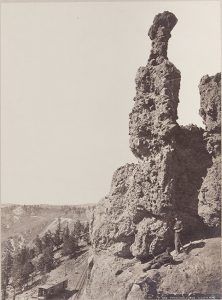
![]() During the 1860s, railroad construction radically changed the face of the frontier. Destroying the lives of Native Americans and greatly altering the environment, the railroad enabled large-scale mining and agriculture, along with the permanent settlements that followed. The railroad was a key element in the rise of the built environment in the West, and the accompanying telegraph lines signaled a contemporaneous rise in communication technology.
During the 1860s, railroad construction radically changed the face of the frontier. Destroying the lives of Native Americans and greatly altering the environment, the railroad enabled large-scale mining and agriculture, along with the permanent settlements that followed. The railroad was a key element in the rise of the built environment in the West, and the accompanying telegraph lines signaled a contemporaneous rise in communication technology.
William Henry Jackson spent part of his youth in Rutland, Vermont, then enlisted in the 12th Vermont Infantry during the Civil War. After a broken engagement, he headed West to work as a bullwhacker on the Oregon Trail. He set up a photography business in Omaha in 1867, then served on the U.S. government survey headed by Ferdinand Vanderveer Hayden from 1871 until its completion in 1878. As a member of the survey, Jackson took some of the first published photographs of the Yellowstone region, documents that led Congress to declare Yellowstone the first national park. In the 1880s, Jackson took on a variety of projects for hotels and railroads, producing thousands of photographs over his long career.
Phantom Curve is located a few miles east of Osier, Colorado. In the early years of Denver and Rio Grande railroad, ghosts were thought to be seen in this stretch of track, although these phantoms were probably the headlights of the locomotives reflecting off the rock formations, or hoodoos, seen in Jackson’s photograph. Jackson shows standing and reclining figures at the base of the rock, while a railroad track, a train car to its side, and telegraph poles are evident in the lower right. These elements speak to the changes taking place in the landscape, as the railroad transformed the natural ecology and social dynamics of the region.
Visiting lecturer and architect, Andrea Murray, shares her thoughts on the photograph: